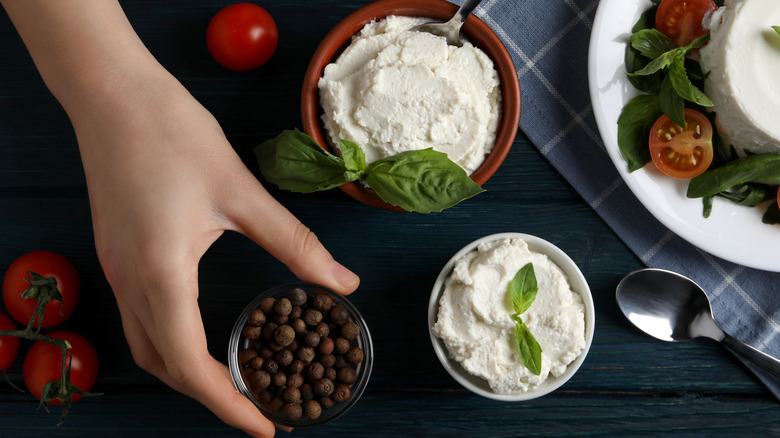A Creamy Italian Cheese With Low Sodium Is One Of The Best To Eat If You Have High Blood Pressure
In a world where almost half of U.S. adults (48.1%) have high blood pressure and only 22.5% of those people have their blood pressure managed (per U.S. Centers for Disease Control and Prevention), knowing what's okay to eat and what you should skip is very important. While it comes as no surprise that fresh vegetables and fruit, as well as whole grains, are essential in keeping blood pressure within a healthy range, it turns out there's an unexpected delicious treat that's also good for that: ricotta cheese.
While cheese, in general, may not be the first thing that comes to mind when thinking about foods that aid in blood pressure management, cheeses like ricotta are a great addition to a heart-friendly diet — in moderation, of course. According to a 2025 study published in The Journal of Dairy Science, cheese consumption significantly influenced 118 metabolic traits, including amino acids, lipids, and inflammation markers. In other words, eating cheese may affect metabolic pathways related to hypertension, which, in the long run, could be great for cardiovascular health.
How ricotta may help lower blood pressure
While the study didn't explain exactly why cheese affects blood pressure pathways, ricotta's mineral profile offers one clue. Not only does ricotta boast a whopping 289 milligrams of calcium per half-cup, but it's also low in sodium. Calcium can help lower blood pressure by promoting relaxation of blood vessel walls, reducing the release of parathyroid hormone (which can raise blood pressure), and modulating the renin-angiotensin system that controls fluid balance and vascular tone. A lower-sodium diet reduces blood pressure by affecting the amount of fluid the body retains, which decreases blood volume and lessens the pressure on blood vessel walls.
Some cheeses like halloumi and Roquefort contain more salt than sea water — no joke — per a 2012 study published in BMJ Open. However, other cheeses, most notably cottage cheese, which has the lowest amount of salt according to the study, fall within the safe sodium content zone. With only 104 milligrams of sodium per half-cup, ricotta is one of those cheeses.
A half-cup serving of ricotta also has 216 calories and 4 grams of net carbs, which is important to keep in mind because when it comes to lowering blood pressure, calories do play a role, as obesity can contribute to hypertension. According to a 2015 study in Circulation Research, excessive weight accounts for up to as many as 75% of increased hypertension cases. So while both dairy and sodium intake should be at the forefront of your thinking when it comes to blood pressure, so should the amount of calories and carbohydrates you ingest.
How to incorporate ricotta cheese into your diet
Although the first couple of dishes that probably come to mind when you hear the word ricotta are lasagna or baked ziti, as much as these are both delicious meals, there are healthier and low-carb options worth giving a try. For example, you can enjoy ricotta on whole grain toast topped with fruit, layered in a berry and granola parfait, or added to breakfast dishes like eggs or pancakes.
You can also replace sour cream with ricotta and make a veggie dip packed with spices and herbs that help lower blood pressure, like garlic, basil, and thyme. Ricotta cheese is also a healthy alternative for cream cheese, so you can top your bagel with it or use it as the base of a cheesecake. Because ricotta is so versatile and can easily be a stand-in for less healthy dairy products, as long as you're not afraid to experiment, you can slip ricotta in pretty much anywhere.
However, the whole key to making sure you're getting the health benefits out of ricotta is about portion control. When incorporating ricotta into your diet, no matter how you choose to enjoy it, it's important to stick to a healthy portion size: ½ cup — this is also 120 grams or eight tablespoons.



